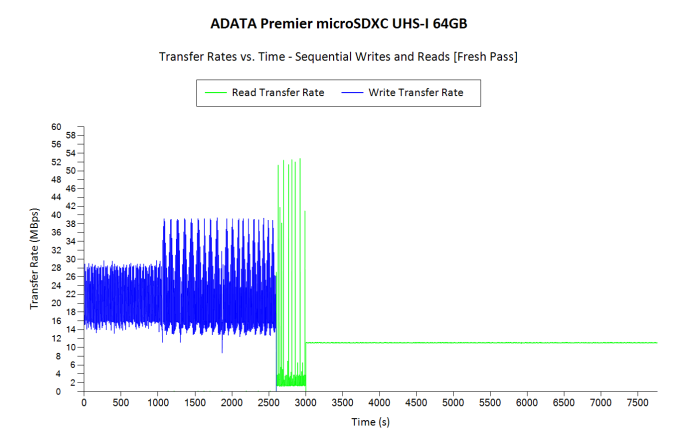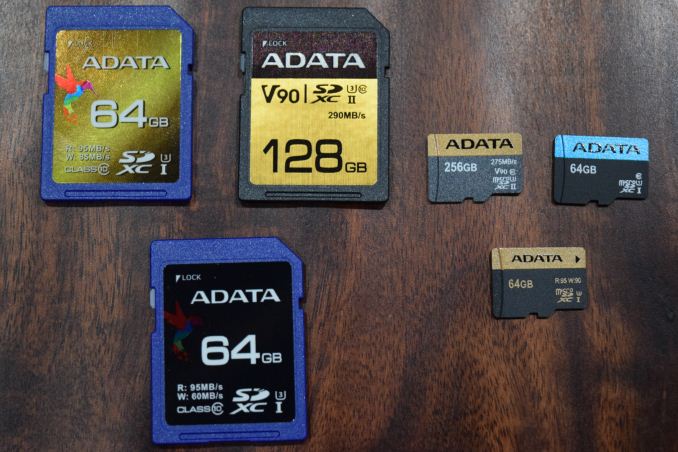
Original Link: https://www.anandtech.com/show/11974/adata-premier-and-xpg-sdxc-and-microsdxc-cards-review
ADATA Premier and XPG SDXC and microSDXC Cards Review
by Ganesh T S on October 30, 2017 8:00 AM EST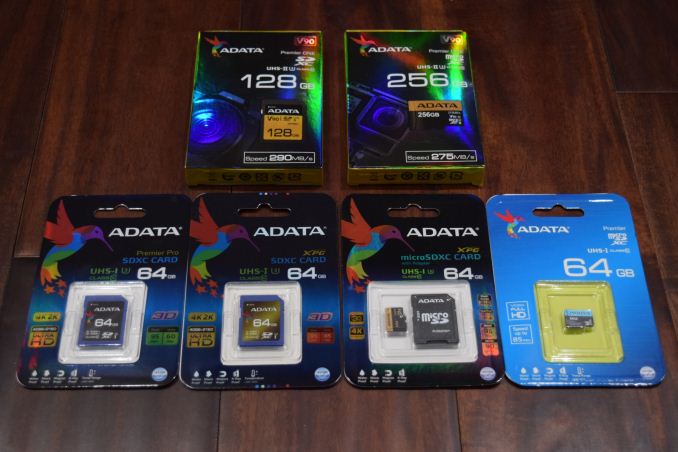
Digital cameras and camcorders employ memory cards (flash-based removable media) for storage of captured content. There are different varieties of memory cards catering to various performance levels. CompactFlash (CF) became popular in the late 90s, but, has now been overtaken by Secure Digital (SD) cards. Many computing systems (PCs as well as smartphones) also support SD cards for augmenting local storage capabilities. We recently started in-depth evaluation of the performance of various memory cards. This piece evaluates a number of memory cards from ADATA.
Introduction
SD (Secure Digital) cards were introduced in 1999, as an update to the existing MultiMediaCards (MMCs). It gained traction even in areas where CompactFlash had been preferred, thanks to its small size. Its popularity is evident by the fact that it has spawned two follow-ups in the same form factor - starting with the SDSC in 1999 for capacities between 1MB and 2GB, we got SD High Capacity (SDHC) in 2006 (up to 32GB) and SD eXtended Capacity (SDXC) in 2009 (up to 2TB). The cards also come in various sizes - standard, mini, and micro. Currently, the standard and micro sizes are more popular in the market. SD's popularity and affordability has meant that almost all consumer cameras come with a SD card slot.
ADATA is a popular vendor in the memory market with their DRAM and SSD lineup. Their expertise with flash obviously places them in a good position to target the memory card market. In particular, they have a large number of SD and microSD cards targeting various performance levels. They sent across 6 different cards (three in SD and three in microSD form factors):
- ADATA Premier ONE 128GB SDXC UHS-II U3 Class10 V90 3D NAND SD Card
- ADATA XPG 64GB SDXC UHS-I U3 Class 10 SD Card
- ADATA Premier Pro 64GB SDXC UHS-I U3 Class 10 SD Card
- ADATA Premier ONE 256GB microSDXC UHS-II U3 Class10 V90 3D NAND microSD Card
- ADATA XPG 64GB microSDXC UHS-I U3 Class 10 microSD Card
- ADATA Premier 64GB SDXC UHS-I U3 Class 10 microSD Card
Each of these six cards were subject to our comprehensive memory card evaluation routine, and five of them emerged unscathed.
The next two sections will details the obtained performance numbers. Prior to that, we take a look at the testbed setup and evaluation methodology.
Testbed Setup and Testing Methodology
Evaluation of memory cards is done on Windows with the testbed outlined in the table below. The USB 3.1 Type-C port enabled by the Intel Alpine Ridge controller. It connects to the Z170 PCH via a PCIe 3.0 x4 link. is used for benchmarking purposes on the testbed side. SD cards utilize the Lexar Professional Workflow SR2 SDHC / SDXC UHS-II USB 3.0 Reader. The reader was placed in the Lexar Professional Workflow HR2 hub and uplinked through its USB 3.0 port with the help of a USB 3.0 Type-A female to Type-C male cable.
| AnandTech DAS Testbed Configuration | |
| Motherboard | GIGABYTE Z170X-UD5 TH ATX |
| CPU | Intel Core i5-6600K |
| Memory | G.Skill Ripjaws 4 F4-2133C15-8GRR 32 GB ( 4x 8GB) DDR4-2133 @ 15-15-15-35 |
| OS Drive | Samsung SM951 MZVPV256 NVMe 256 GB |
| SATA Devices | Corsair Neutron XT SSD 480 GB Intel SSD 730 Series 480 GB |
| Add-on Card | None |
| Chassis | Cooler Master HAF XB EVO |
| PSU | Cooler Master V750 750 W |
| OS | Windows 10 Pro x64 |
| Thanks to Cooler Master, GIGABYTE, G.Skill and Intel for the build components | |
The full details of the reasoning behind choosing the above build components can be found here.
Premier ONE, Premier Pro, & XPG SDXC Cards Performance
The first performance section deals with the cards in the SD form factor. The Premier ONE with its UHS-II rating is the flagship, while the Premier Pro and the XPG (UHS-I) carry similar performance numbers.
Sequential Accesses
ADATA claims speeds of up to 290 MBps for the Premier ONE and 95 MBps for the other two, but real-world speeds are bound to be lower. In fact, writes can sometimes be much slower. For most applications, that really doesn't matter as long as the card is capable of sustaining the maximum possible rate at which the camera it is used in dumps data. We use fio workloads to emulate typical camera recording conditions. We run the workload on a fresh card, and also after simulating extended usage. Instantaneous bandwidth numbers are graphed. This gives an idea of performance consistency (whether there is appreciable degradation in performance as the amount of pre-existing data increases and / or the card is subject to wear and tear in terms of amount and type of NAND writes). Further justification and details of the testing parameters are available here.
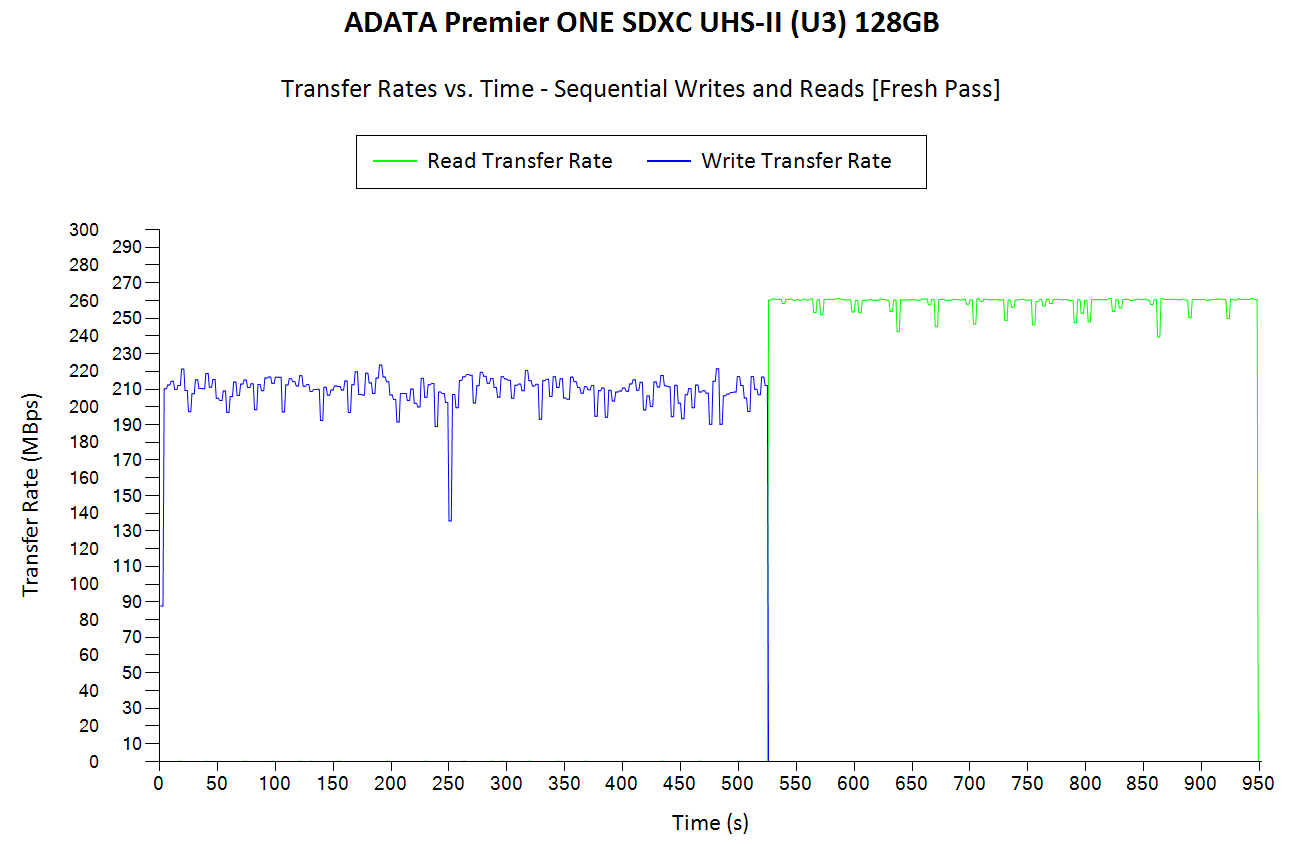
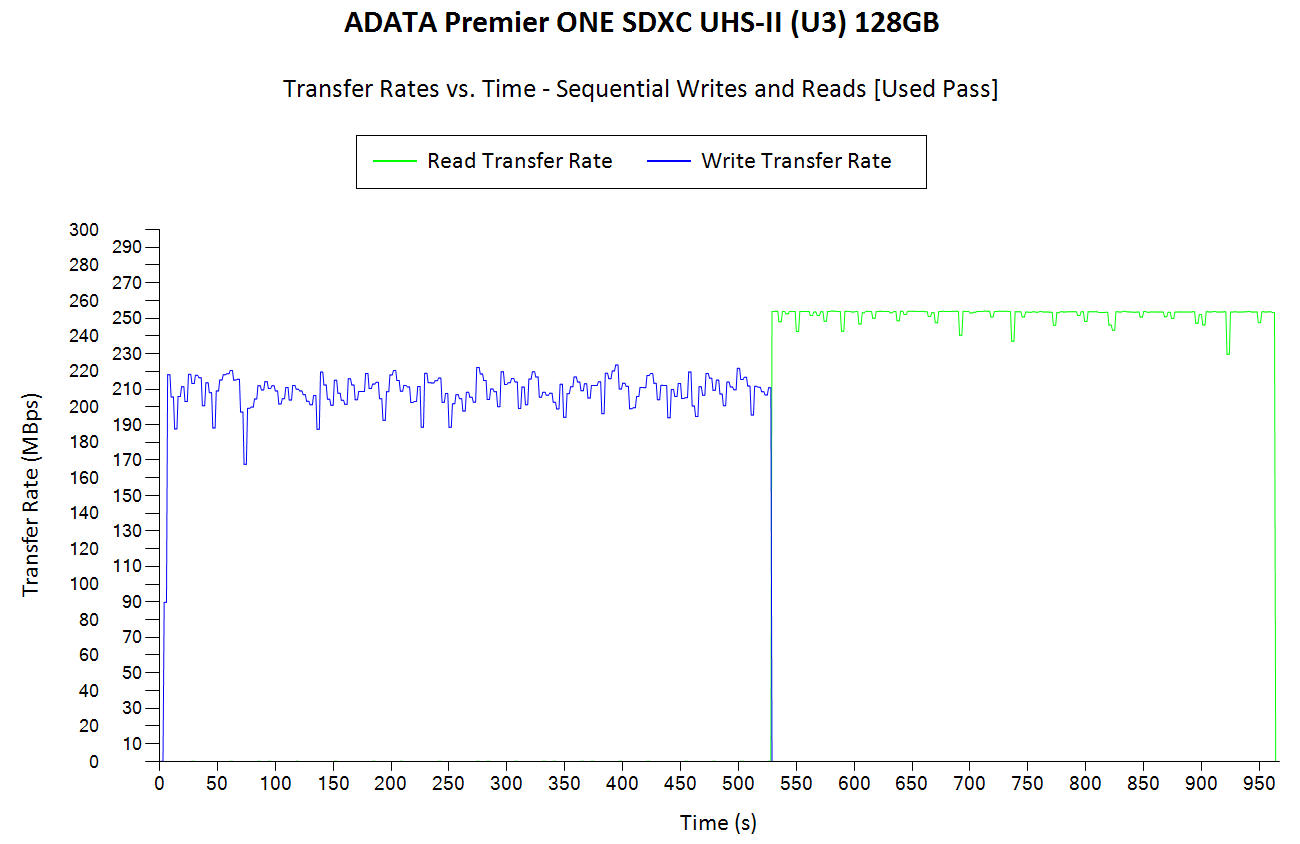
The Premier ONE is outright impressive. It exhibits remarkable performance consistency compared to the other SDXC cards (including the Lexar one that we reviewed earlier this year). Even under sustained loading conditions, it is able to maintain more than 130 MBps of writes. Unfortunately, the same praise can't be given to the XPG and Premier Pro. While the write performance consistency can be appreciated for the two cards in the fresh case, the same benchmark after subject to simulation of extended usage reveals their shortcomings. We see writes dropping down to 12 - 15 MBps occassionally.
AnandTech DAS Suite - Performance Consistency
The AnandTech DAS Suite involves transferring large amounts of photos and videos to and from the storage device using robocopy. This is followed by selected workloads from PCMark 8's storage benchmark in order to evaluate scenarios such as importing media files directly into multimedia editing programs such as Adobe Photoshop. Details of these tests from the perspective of memory cards are available here.
In this subsection, we deal with performance consistency while processing the robocopy segment. The graph below shows the read and write transfer rates to the memory card while the robocopy processes took place in the background. The data for writing to the card resides in a RAM drive in the testbed. The first three sets of writes and reads correspond to the photos suite. A small gap (for the transfer of the videos suite from the primary drive to the RAM drive) is followed by three sets for the next data set. Another small RAM-drive transfer gap is followed by three sets for the Blu-ray folder. The corresponding graphs for similar cards that we have evaluated before is available via the drop-down selection.
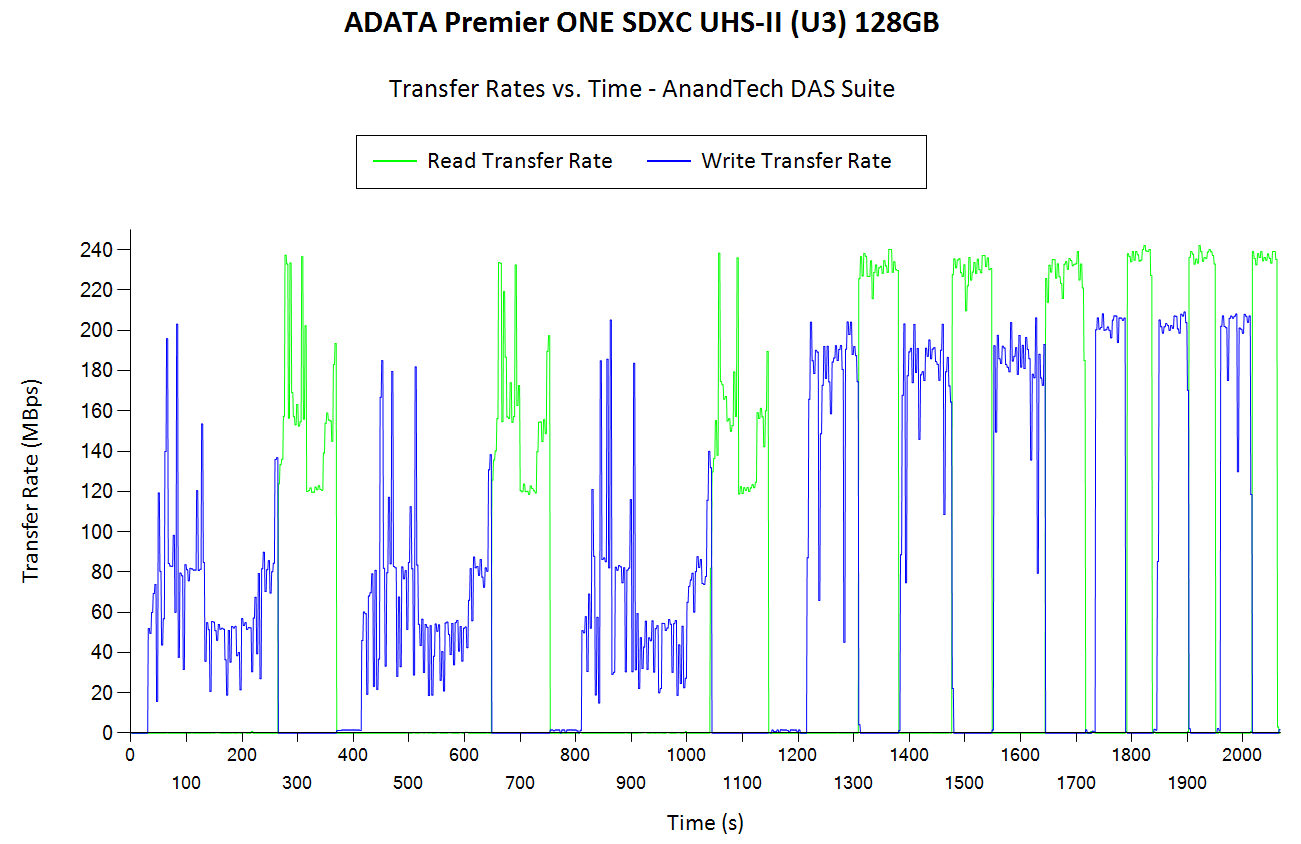
The testing doesn't reveal any throttling or significant effects due to fill up of an internal SLC cache or any other such mechanism. The performance numbers themselves tally with the claims of the manufacturers.
AnandTech DAS Suite - Bandwidth
The average transfer rates for each workload from the previous section is graphed below. Readers can get a quantitative number to compare the ADATA Premier ONE SDXC UHS II 128GB SD card against the ones that we have evaluated.
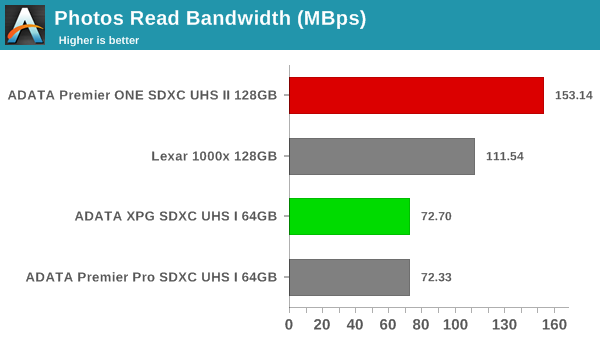
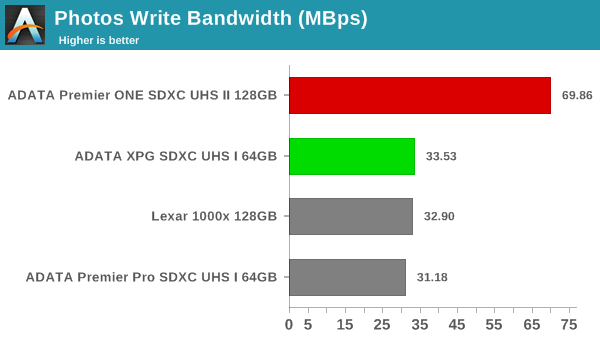
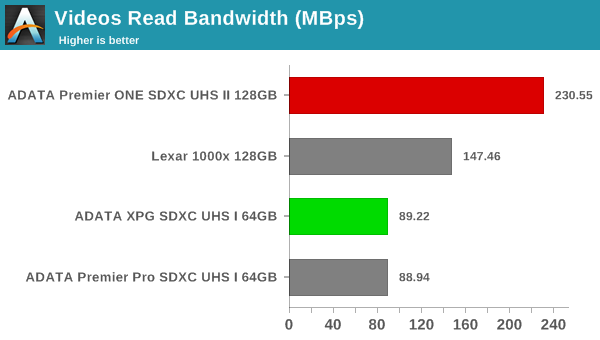
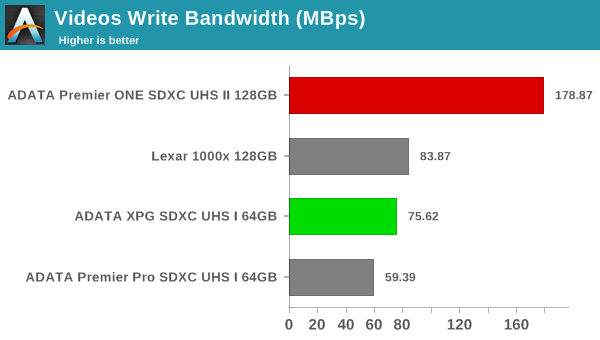
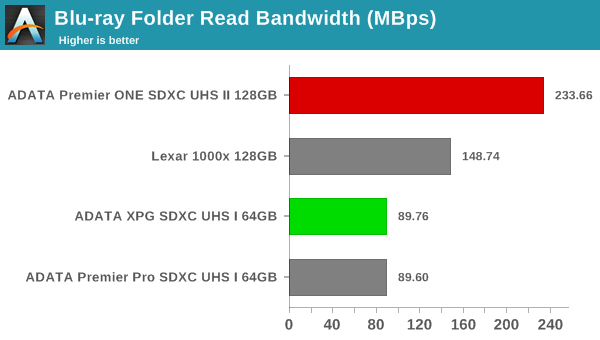
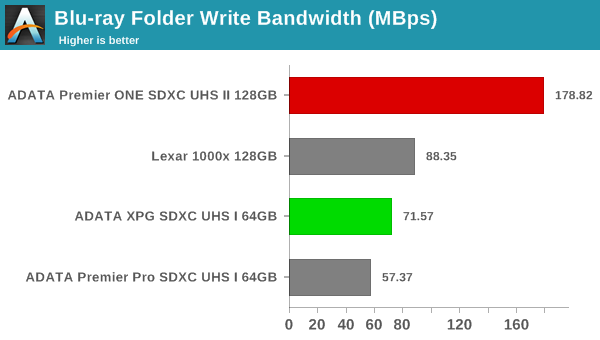
We also look at the PCMark 8 storage bench numbers in the graphs below. Note that the bandwidth number reported in the results don't involve idle time compression. Results might appear low, but that is part of the workload characteristic. Note that the same testbed is being used for all memory cards. Therefore, comparing the numbers for each trace should be possible across different cards.
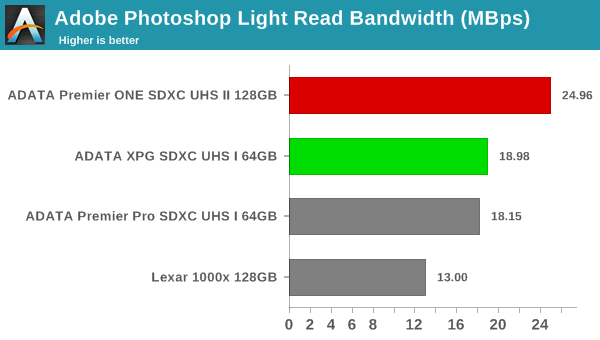
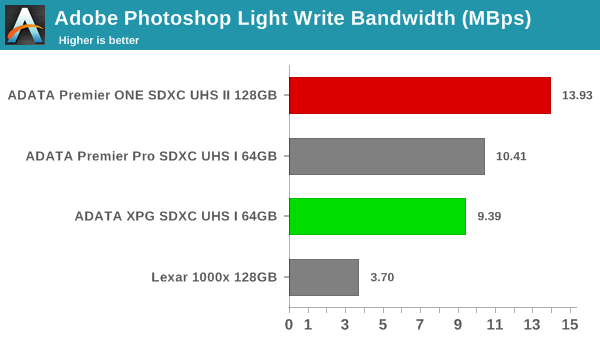
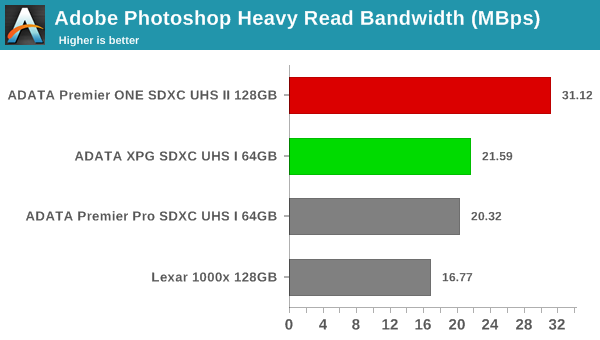
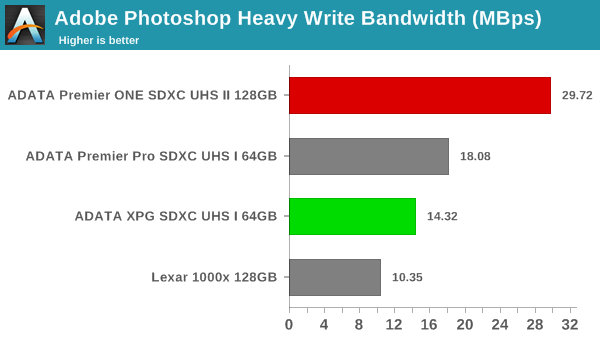
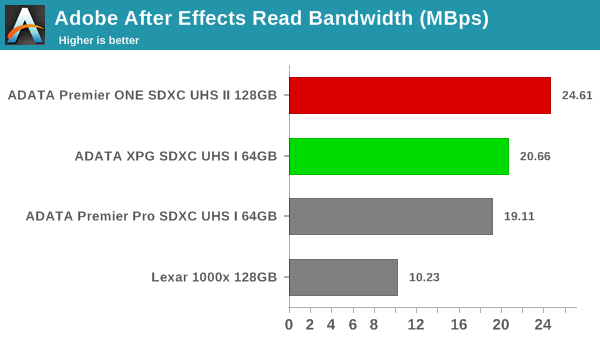
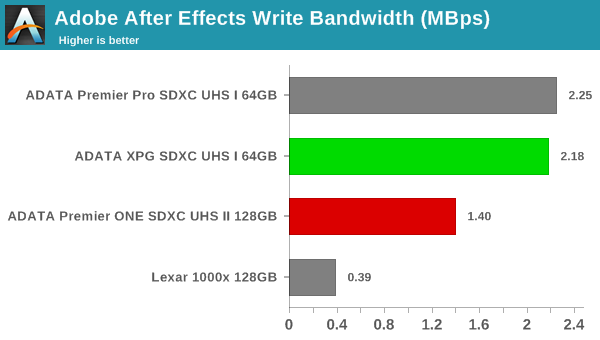
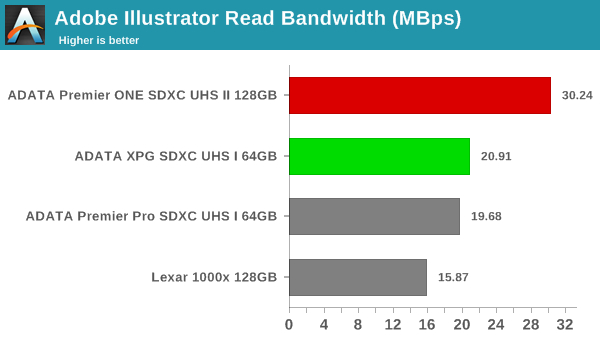
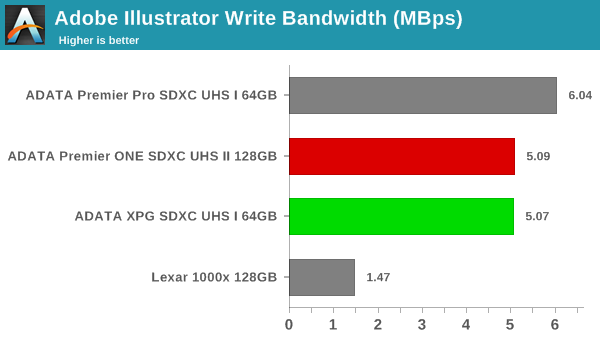
Performance Restoration
The traditional memory card use-case is to delete the files on it after the import process is completed. Some prefer to format the card either using the PC, or, through the options available in the camera menu. The first option is not a great one, given that flash-based storage devices run into bandwidth issues if garbage collection (processes such as TRIM) is not run regularly. Different memory cards have different ways to bring them to a fresh state.Based on our experience, SD cards have to be formatted using the SD Formatter tool from the SD Association (after all the partitions are removed using the 'clean' command in diskpart).
In order to test out the effectiveness of the performance restoration process, we run the default sequential workloads in CrystalDiskMark before and after the formatting. Note that this is at the end of all our benchmark runs, and the card is in a used state at the beginning of the process. The corresponding screenshots for similar cards that we have evaluated before is available via the drop-down selection.
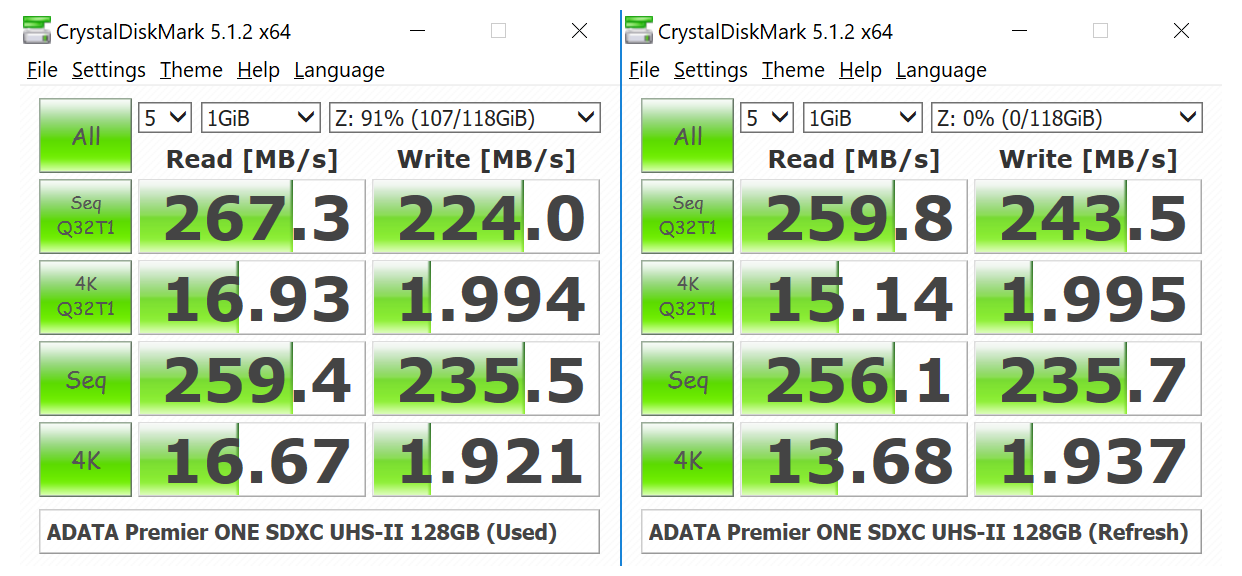
The XPG seems to benefit from the performance restoration process, but, the effect in the Premier ONE and the Premier Pro seems minimal. Consumers should expect the performance to go down with extended usage.
Premier ONE & XPG microSDXC Cards Performance
The second performance section deals with the cards in the microSD form factor. The Premier ONE with its UHS-II rating is the flagship, while the Premier and the XPG (UHS-I) carry similar performance numbers. We will not be looking at the obtained performance numbers for the Premier card in this section.
Sequential Accesses
ADATA claims speeds of up to 275 MBps and 95 MBps for the Premier ONE and XPG microSDXC cards, but real-world speeds are bound to be lower. In fact, writes can sometimes be much slower. For most applications, that really doesn't matter as long as the card is capable of sustaining the maximum possible rate at which the camera it is used in dumps data. We use fio workloads to emulate typical camera recording conditions. We run the workload on a fresh card, and also after simulating extended usage. Instantaneous bandwidth numbers are graphed. This gives an idea of performance consistency (whether there is appreciable degradation in performance as the amount of pre-existing data increases and / or the card is subject to wear and tear in terms of amount and type of NAND writes). Further justification and details of the testing parameters are available here.


Compared to the Lexar microSDXC card evaluated before, ADATA's offerings have major consistency issues. In the fresh case, we see the Premier ONE try to move into higher write performance territory before literally dropping out for a couple of seconds. The read performance also varies widely. After being subject to extended usage, the consistency improves, but the performance numbers are literally half of what was obtained out of the box. The XPG performs marginally better. The performance numbers are approximately the same between the fresh and used cases, but, the sequential write speeds are hampered initially in the used case.
AnandTech DAS Suite - Performance Consistency
The AnandTech DAS Suite involves transferring large amounts of photos and videos to and from the storage device using robocopy. This is followed by selected workloads from PCMark 8's storage benchmark in order to evaluate scenarios such as importing media files directly into multimedia editing programs such as Adobe Photoshop. Details of these tests from the perspective of memory cards are available here.
In this subsection, we deal with performance consistency while processing the robocopy segment. The graph below shows the read and write transfer rates to the memory card while the robocopy processes took place in the background. The data for writing to the card resides in a RAM drive in the testbed. The first three sets of writes and reads correspond to the photos suite. A small gap (for the transfer of the videos suite from the primary drive to the RAM drive) is followed by three sets for the next data set. Another small RAM-drive transfer gap is followed by three sets for the Blu-ray folder. The corresponding graphs for similar cards that we have evaluated before is available via the drop-down selection.

The performance consistency with our DAS suite workload is surprisingly not bad (after what we saw in the previous sub-section). There is no throttling or caching effects at play.
AnandTech DAS Suite - Bandwidth
The average transfer rates for each workload from the previous section is graphed below. Readers can get a quantitative number to compare the ADATA Premier ONE microSDXC UHS II 256GB and the XPG microSDXC UHS I 64GB microSD cards against the ones that we have evaluated before.
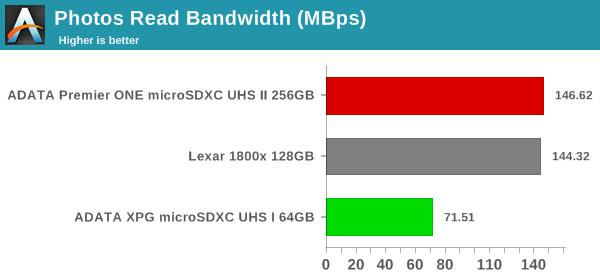
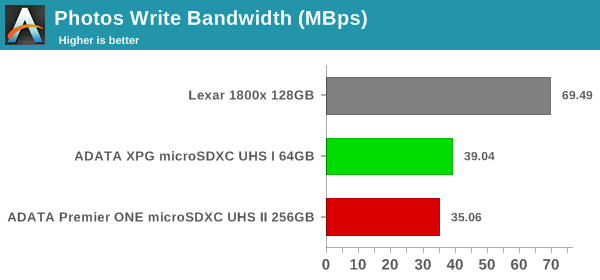
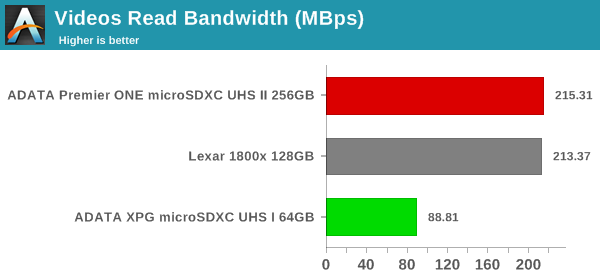
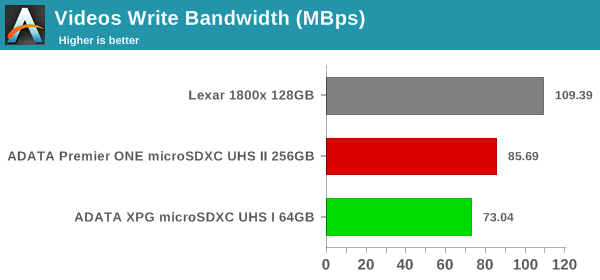
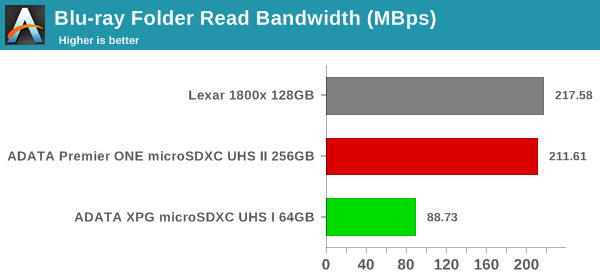
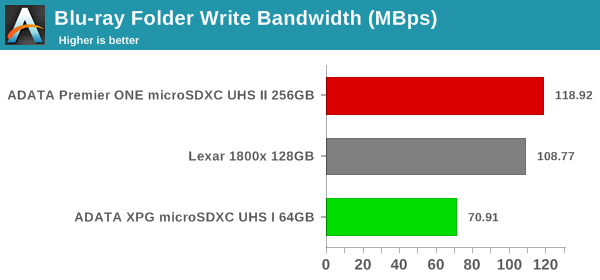
We also look at the PCMark 8 storage bench numbers in the graphs below. Note that the bandwidth number reported in the results don't involve idle time compression. Results might appear low, but that is part of the workload characteristic. Note that the same testbed is being used for all memory cards. Therefore, comparing the numbers for each trace should be possible across different cards.
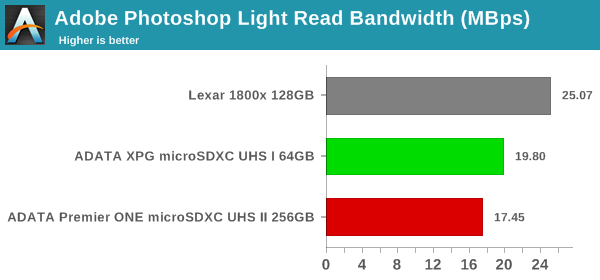
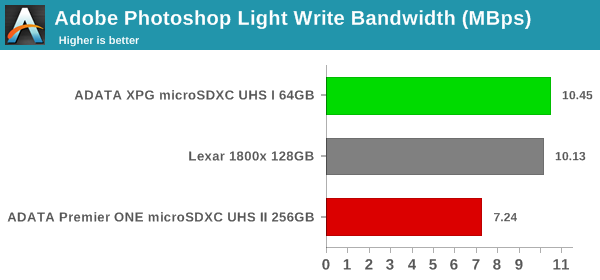
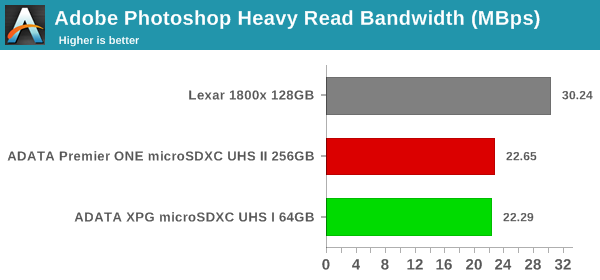
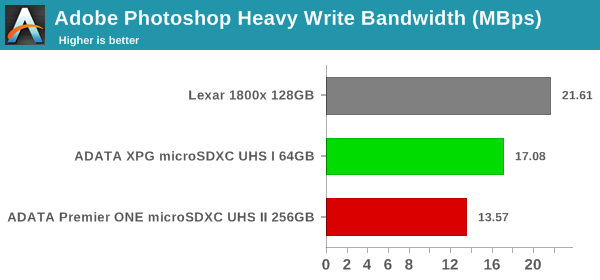
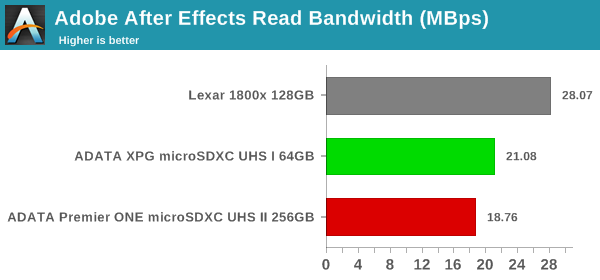
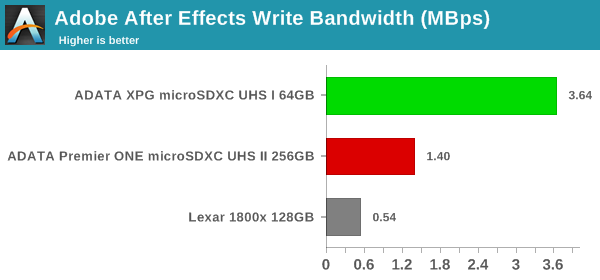
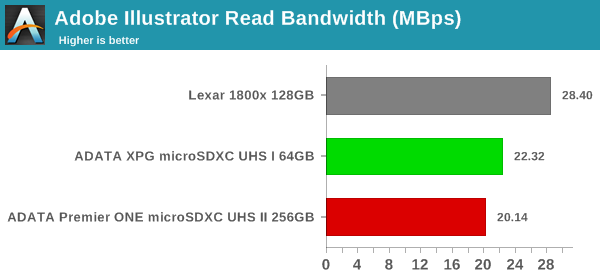
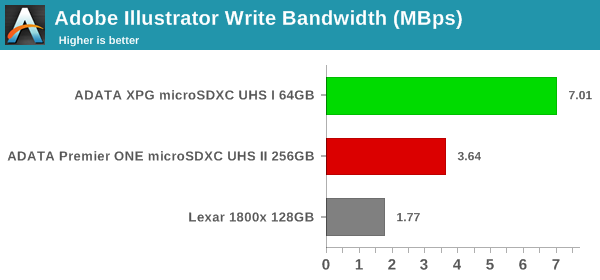
Performance Restoration
The traditional memory card use-case is to delete the files on it after the import process is completed. Some prefer to format the card either using the PC, or, through the options available in the camera menu. The first option is not a great one, given that flash-based storage devices run into bandwidth issues if garbage collection (processes such as TRIM) is not run regularly. Different memory cards have different ways to bring them to a fresh state.Based on our experience, uSD cards have to be formatted using the SD Formatter tool from the SD Association (after all the partitions are removed using the 'clean' command in diskpart).
In order to test out the effectiveness of the performance restoration process, we run the default sequential workloads in CrystalDiskMark before and after the formatting. Note that this is at the end of all our benchmark runs, and the card is in a used state at the beginning of the process. The corresponding screenshots for similar cards that we have evaluated before is available via the drop-down selection.

Using SD Formatter doesn't help much in performance restoration. The benchmark numbers are similar in both the used and refreshed scenarios.
Miscellaneous Aspects and Concluding Remarks
Readers might have noticed that we refrained from including the benchmark numbers for the Premier microSD card sample. Unfortunately, this card could not successfully complete our evaluation workloads. Around 60% into the fio workload for the fresh pass, the card slipped into read-only mode. We were unsuccessful in getting the card to work again despite trying with different hosts. Based on the Amazon reviews for the SKU, it does appear that the Premier's problem is widespread.
In addition to raw performance and consistency, pricing is also an important aspect. This is particularly important in the casual user and semi-professional markets, where the value for money metric often trumps benchmark numbers. The tables below presents the relevant data for the cards ordered by the $/GB metric.
| SD Cards - Pricing | ||||
| Card | Model Number | Capacity (GB) | Street Price (USD) | Price per GB (USD/GB) |
| ADATA Premier Pro SDXC UHS I 64GB | ASDX64GUI3CL10-R | 64 | 41 | 0.64 |
| Lexar 1000x 128GB | LSD128CRBNA1000 | 128 | 95 | 0.74 |
| ADATA XPG SDXC UHS I 64GB | ASDX64GXUI3CL10-R | 64 | 83 | 1.30 |
| ADATA Premier ONE SDXC UHS II 128GB | ASDX128GUII3CL10-C | 128 | 200 | 1.56 |
| uSD Cards - Pricing | ||||
| Card | Model Number | Capacity (GB) | Street Price (USD) | Price per GB (USD/GB) |
| ADATA XPG microSDXC UHS I 64GB | AUSDX64GXUI3-RA1 | 64 | 50 | 0.78 |
| ADATA Premier ONE microSDXC UHS II 256GB | AUSDX256GUII3CL10-C | 256 | 261 | 1.02 |
| Lexar 1800x 128GB | LSDMI128CRBNA1800R | 128 | 233 | 1.82 |
Out of the cards that we have evaluated, we have no qualms in recommending the ADATA Premier ONE SD Card and the ADATA XPG microSDXC Card. The former's performance earns it the recommendation despite its cost on a per-GB basis. The microSD XPG, on the other hand, is purely a value play. The other cards, despite coming out unscathed in our benchmark routines, are not as consistent as the above two. On the microSD front, people looking for a card with high-end performance might want to consider the Lexar option (or, wait for our upcoming review of some SanDisk cards).

